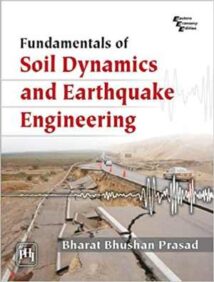نام کتاب: Fundamentals Of Soil Dynamics And Earthquake Engineering
نویسنده: Bharat Bhushan Prasad
ویرایش: ۱
سال انتشار: ۲۰۰۹
کد ISBN کتاب: ۹۷۸۸۱۲۰۳۲۶۷۰۵,
فرمت: PDF
تعداد صفحه: ۵۸۴
حجم کتاب: ۵٫۶ مگابایت
کیفیت کتاب: OCR
انتشارات: PHI Learning Pvt. Ltd.
Description About Book Fundamentals Of Soil Dynamics And Earthquake Engineering From Amazon
The majority of the cases of earthquake damage to buildings, bridges, and other retaining structures are influenced by soil and ground conditions. To address such phenomena, Soil Dynamics and Earthquake Engineering is the appropriate discipline. This textbook presents the fundamentals of Soil Dynamics, combined with the basic principles, theories and methods of Geotechnical Earthquake Engineering. It is designed for senior undergraduate and postgraduate students in Civil Engineering Architecture. The text will also be useful to young faculty members, practising engineers and consultants. Besides, teachers will find it a useful reference for preparation of lectures and for designing short courses in Soil Dynamics and Geotechnical Earthquake Engineering. The book first presents the theory of vibrations and dynamics of elastic system as well as the fundamentals of engineering seismology. With this background, the readers are introduced to the characteristics of Strong Ground Motion, and Deterministic and Probabilistic seismic hazard analysis. The risk analysis and the reliability process of geotechnical engineering are presented in detail. An in-depth study of dynamic soil properties and the methods of their determination provide the basics to tackle the dynamic soil–structure interaction problems. Practical problems of dynamics of beam–foundation systems, dynamics of retaining walls, dynamic earth pressure theory, wave propagation and liquefaction of soil are treated in detail with illustrative examples.
درباره کتاب Fundamentals Of Soil Dynamics And Earthquake Engineering ترجمه شده از گوگل
اکثر موارد آسیب ناشی از زلزله به ساختمان ها، پل ها و سایر سازه های حائل تحت تأثیر شرایط خاک و زمین است. برای پرداختن به چنین پدیده هایی، دینامیک خاک و مهندسی زلزله رشته مناسبی است. این کتاب درسی مبانی دینامیک خاک را همراه با اصول اولیه، تئوری ها و روش های مهندسی ژئوتکنیک زلزله ارائه می کند. این برای دانشجویان ارشد و کارشناسی ارشد در رشته معماری مهندسی عمران طراحی شده است. این متن همچنین برای اعضای هیأت علمی جوان، مهندسان و مشاوران جوان مفید خواهد بود. علاوه بر این، معلمان آن را مرجع مفیدی برای آماده سازی سخنرانی ها و طراحی دوره های کوتاه مدت در دینامیک خاک و مهندسی ژئوتکنیک زلزله خواهند دانست. این کتاب ابتدا تئوری ارتعاشات و دینامیک سیستم الاستیک و همچنین مبانی زلزله شناسی مهندسی را ارائه می دهد. با این پیشینه، خوانندگان با ویژگیهای حرکت قوی زمین، و تحلیل خطر لرزهای قطعی و احتمالی آشنا میشوند. تجزیه و تحلیل ریسک و فرآیند قابلیت اطمینان مهندسی ژئوتکنیک به تفصیل ارائه شده است. مطالعه عمیق ویژگیهای خاک پویا و روشهای تعیین آنها، پایههایی را برای مقابله با مشکلات اندرکنش دینامیکی خاک-ساختار فراهم میکند. مشکلات عملی دینامیک سیستمهای تیر-پی، دینامیک دیوارهای حائل، تئوری فشار دینامیکی زمین، انتشار موج و روانگرایی خاک به تفصیل با مثالهای گویا بررسی میشوند.
[box type=”info”]![]() جهت دسترسی به توضیحات این کتاب در Amazon اینجا کلیک کنید.
جهت دسترسی به توضیحات این کتاب در Amazon اینجا کلیک کنید.![]() در صورت خراب بودن لینک کتاب، در قسمت نظرات همین مطلب گزارش دهید.
در صورت خراب بودن لینک کتاب، در قسمت نظرات همین مطلب گزارش دهید.

